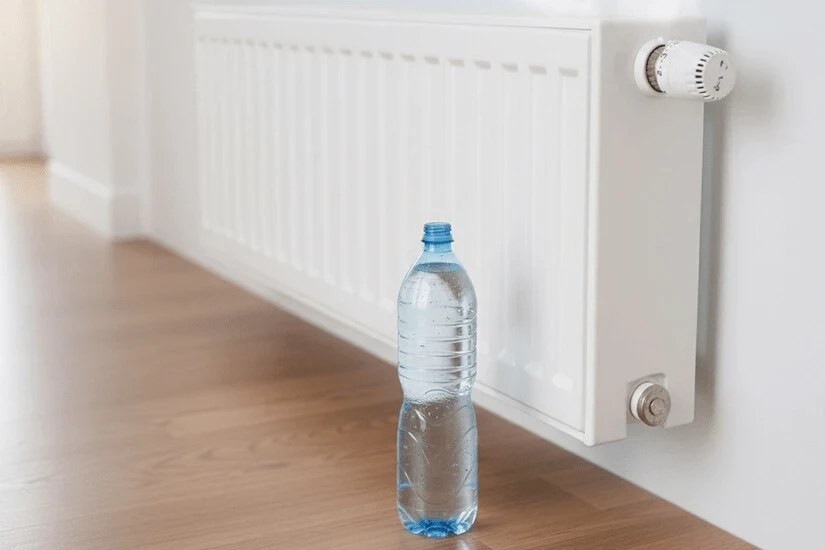Winter Is Coming: The Water Bottle Trick to Heat Your Home While Spending Less

With the cold nights setting in, the fear of expensive heating bills is fast approaching. While well-known steps like insulation or bleeding your radiators are common enough, a simple, budget-friendly tip may help in lowering those heating bills: putting a bottle of water next to your radiators. This heating hack, backed by physics, might just help you heat your home more cost effectively. But does it really work?
The Thermal Battery Principle: How Does It Work?
Far from being a crazy idea, this trick is based on a simple scientific principle: the heat capacity of water.
Water has a very high heat capacity, which means it can absorb a large amount of heat before its own temperature increases significantly.
When you place a bottle filled with water next to a running radiator, the water will slowly absorb the heat emitted.
Once the radiator turns off (because the thermostat has reached the set temperature), the water in the bottle, which has stored the heat, will slowly release it back into the room.
The bottle then acts as a sort of "thermal battery" , prolonging the diffusion of heat and maintaining a more stable temperature, even when the home heating is no longer actively working.
Electricity Bills Costing You Too Much in 2025?
Talk to us here at Selectra and we can help you make the right choice and save money!
Call Today to Switch Energy Providers and Save On Your Energy Bills
We're currently closed but please leave us your number and we'll give you a free call as soon as we're open!
In Practice, How Do I Set It Up?
To make this tip effective, follow these few simple steps:
- Use plastic bottles: No need to buy anything, simple plastic water bottles that you reuse will do the trick perfectly.
- Place them near your radiators: Ideally, they should be placed near the floor, next to the radiators, where they can absorb the most heat.
- Make sure they are tightly closed: This helps maximise heat retention and prevent evaporation.
- Multiply the bottles: The larger the quantity of water, the more significant the “thermal battery” effect will be. Don't hesitate to place several bottles in the largest or coldest rooms.
How Much Could I Save?
This is the big question.
Articles popularising this tip sometimes put forward ambitious figures, ranging from 10% to 20% savings on the portion of the bill related to heating.
However, these estimates should be taken with a pinch of salt.
While the physical principle of thermal inertia is very real, the impact of a few bottles of water remains very small on a room to room scale.
The amount of energy stored and released is minimal compared to the volume of air to be heated and the thermal mass of the walls and furniture.
Therefore, the effect on the thermostat triggering, and therefore on your bill, will probably be marginal, if not imperceptible.
The interest of this tip is therefore more symbolic: it illustrates an interesting principle and encourages us to think about optimising our heating.
For much more concrete and measurable savings, it is recommended to combine it with actions of proven effectiveness, such as bleeding radiators, insulating windows or using thermostatic valves
The Other Trick: The Glass of Water for Humidity
Here, the principle is different. By placing a glass of water (or a bowl) directly on the radiator is not about storing heat, but about increasing the humidity level in the room.
Air heated by radiators tends to dry out. However, air that's too dry (below 40% humidity) feels cold, even at a temperature of 20 °C. This causes us to turn up the heating unnecessarily.
By placing a container of water on the radiator, the water evaporates and humidifies the air, which increases the feeling of comfort and warmth at the same temperature.
For a very large, very dry home, or for people with respiratory problems, this method will never replace a real electric air humidifier, which is much more powerful and controllable
Other Ways to Increase Your Home Heating Efficiency
These tips, as ingenious as they may be, are even more effective when combined with other good heating management practices.
To maximise your savings, also consider:
- Bleed your radiators at the start of winter to remove air and ensure even heat distribution.
- Insulate doors and windows with insulators or thick curtains to prevent heat loss.
- Do not overheat: The ideal temperature recommended is 19 °C in living rooms and 17 °C in bedrooms.
- Install thermostatic valves on your radiators to adjust the temperature room by room.
Looking For Other Ways to Reduce Your Energy Bill?
Stay up to date with the latest news from Selectra to learn how to lower your energy bills or find a cheaper electricity provider.

